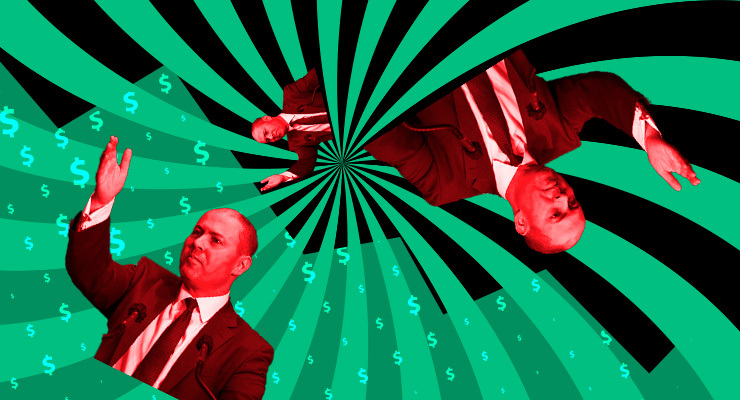
The Australian economy isn’t merely in recession, and won’t merely need a major increase in government spending to deliver recovery: it is entering a whole new era of massive government spending just to deliver the kind of employment we’ve taken for granted for two decades.
The Morrison government has committed not only to huge deficit spending, but also to pushing the size of government as a proportion of the economy to levels never before seen.
It will be a gobsmacking 34.8% of GDP in 2020-21 — off the back of a 22.6% increase in spending this year (Rudd managed only a 12.7% increase in spending in 2009, and copped hell for it from the commentariat) — dipping to 28% next year and floating at around 27% in 2024.
But what will really fuel such massive deficits is that the government is going to have to make do with the kind of tax levels that Labor had to work with during its time in government. When Wayne Swan was treasurer, the proportion of tax to GDP never got above 21.7%. Until 2020, the Coalition never had it below 21.8%, and had plans to use bracket creep to drive it above 23% so it could boast it returned the budget to surplus.
The pandemic has wrecked that plan — tax to GDP is below 22% this year, below 21% next year and only struggles back above 22% in 2024.
With deficits totaling $480 billion over coming years — not to forget interest rates set at next-to-zero levels — what kind of economic growth will we get? The budget papers suggest we’re starting off a little better than we thought: the estimate for growth this year has been revised up from -2.5% in the July update to -1.5%.
And the government hopes its mix of pump-priming and private spending will deliver a recovery year of strong growth in 2021-22 — coincidentally, when the next election is due — with growth reaching 4.75% and unemployment pushed down to 6.5%.
Households and businesses will fuel that growth: the government predicts a 7% rise in household spending, a 7.5% rise in non-mining business investment and a 7% rise in housing investment.
That triple seven is the key to an election-year GDP surge — but thereafter growth will fall away. Scott Morrison’s commitment to growth of at least 3.75% each year for five years has already been dumped: growth in 2022-23 will fall back to 2.75%, then reach 3% in 2023-24. That will be enough to get unemployment down to 5.5%, or only a little higher than before we entered the crisis.
Just to show that old habits die hard, the government also assumes that by then, wages growth will have returned to a whopping 2.25% — a level it only briefly reached before the pandemic wreaked havoc.
The weaker growth is less surprising given the lower population estimates: after a blatant deception in last year’s budget to pretend a surge in population was on the way, a more realistic forecast this year sees our fertility rate falling to 1.58 babies per woman before rising again to 1.69 by 2024. Last year’s forecast of 1.9 babies now looks particularly laughable, while net overseas migration isn’t expected to turn positive again until 2023.
Nor will trade help the economy much, at least in the forecasts: Treasury has conservatively estimated iron ore will decline in price; our terms of trade will decline 10.75% next year, with the current account deficit returning after two years of unusual surpluses. If the government’s economic plan turns out as forecast tonight, we’ll return to something like a pre-COVID economy at the end of 2024 — but with government still playing an extraordinarily large role in our economy, funded by the sort of debt levels that would have seemed nonsensical just a few months ago.








Was it palm reading, tea leaves, or tarot cards that Joshy used to come up with his “estimates”?
Given his record so far I hope it wasn’t a calculator and spreadsheet!